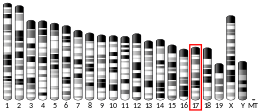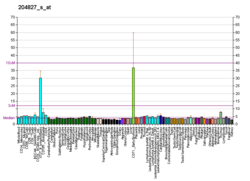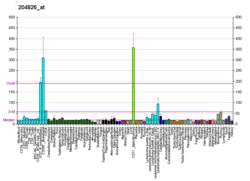CCNF
G2/mitotic-specific cyclin-F is a protein that in humans is encoded by the CCNF gene.[5][6]
- CCNF may also mean Canonical conjunctive normal form in Boolean algebra.
Function
This gene encodes a member of the cyclin family. Cyclins are important regulators of cell cycle transitions through their ability to bind and activate cyclin-dependent protein kinases. This member also belongs to the F-box protein family which is characterized by an approximately 40 amino acid motif, the F-box. The F-box proteins constitute one of the four subunits of the ubiquitin protein ligase complex called SCFs (SKP1-cullin-F-box), which are part of the ubiquitin-proteosome system (UPS). The F-box proteins are divided into 3 classes: Fbws containing WD-40 domains, Fbls containing leucine-rich repeats, and Fbxs containing either different protein-protein interaction modules or no recognizable motifs. The protein encoded by this gene belongs to the Fbxs class and it was one of the first proteins in which the F-box motif was identified.[6]
Discovery and gene/protein characteristics
CCNF gene was first discovered in 1994 by the Elledge laboratory while experimenting with Saccharomyces cerevisiae.[7] At the same time, the Frischauf laboratory also identified cyclin F as a new cyclin during their search for new candidate genes for polycystic kidney.[8] CCNF gene has 17 exons and is located at position 16p13.3 on the human chromosome.[7] Its protein, cyclin F, is made up of 786 amino acids and has a predicted molecular weight of 87 kDa.[7] Cyclin F is the main member of the F-box protein family, which has about 40 amino acid motif, forming the F-box.[7]
Cyclin F resembles most to cyclin A in terms of sequence and expression patterns.[7] Moreover, it has additional shared features of cyclins, such as pEST region, protein quantity, localization, cell cycle-regulated mRNA, and ability to influence cell cycle and progression.[7] Cyclin F differs from other cyclins by its ability to monitor and regulate cell cycle without the need for cyclin-dependent kinases (CDKs).[9] Instead, the Pagano laboratory found that cyclin F is the substrate receptor of an SCF ubiquitin ligase that ubiquitinates and directly interacts with downstream targets, such as CP110 and RRM2, through its hydrophobic patch.[9]
Expression patterns
Cyclin F mRNA is expressed in all human tissues, but at different quantities.[7] It is found most abundantly in the nucleus, and the quantity levels vary during the different stages of cell cycle.[7] Its expression pattern closely resembles the one from cyclin A. Cyclin F levels begin to rise during S phase and reaches its peak during G2.[7]
Role
Cyclin F interacts with other proteins that are important for centrosomal duplication, gene transcription, and DNA synthesis, stability and repair.
RRM2
RRM2 is a ribonucleotide reductase (RNR), an enzyme responsible for the conversion of ribonucleotides into dNTPs. dNTPs are essential for DNA synthesis during DNA replication and repair.[10] Cyclin F interacts with RRM2 to control the production of dNTPs in the cell to avoid genomic instability and frequency of mutations.[11]
CP110
Moreover, cyclin F located at the centrosomes are needed to regulate levels of CP110, a protein involved in centrosome duplication.[12] The regulation of CP110 during G2, through ubiquitin mediated proteolysis, helps to prevent mitotic aberrations.[12] by allowing only one centrosome replication per cell cycle.
NuSAP
NuSAP is a substrate of cyclin F that is involved in cell division.[13] It is a microtubule-associated protein that is required for the spindle assembly process.[14] Its function is to interact with microtubules and chromatin to create stabilization and cross-linking.[14] A lack of NuSAP has been linked with an increase in mutations due to impaired chromosome alignment during metaphase, while an excess of NuSAP leads to mitotic arrest and microtubule bundling.[15] Cyclin F help to control NUSAP abundance and is therefore essential to proper cell division.
SLBP
SLBP is a protein that controls the mRNAs encoding canonical histones and H2A.X, thereby synchronizing histone metabolism with the cell cycle. In the G2 phase of the cell cycle, SLBP is degraded via cyclin F to control H2A.X levels after genotoxic stress.[16]
Clinical significance
Neurodegenerative diseases
CCNF mutations have more recently been associated to neurodegenerative diseases such as frontotemporal dementia (FTD), amyotrophic lateral sclerosis (ALS), and co-morbid ALS-FTD.[19][20] Whole-genome linkage analysis and genome sequencing identified CCNF to be linked to both familial and sporadic ALS patients.[19] In vitro and in vivo studies using ALS-linked mutations in CCNF were also carried out. It was found that certain CCNF mutations caused increased ubiquitylation activity of cyclin F [21] leading to abnormal ubiquitylation of proteins.[19][22] In zebrafish, mutant CCNF fish showed motor neuron axonopathy and reduced motor response.[23]
Cancer
Cyclin F has a tumor suppressor role because normal expression is involved in cell cycle regulation by inducing G2 arrest and preventing mitosis.[24] Moreover, cyclin F through RRM2 and CP110 control centrosome duplication and reduce the frequency of genomic mutations.[9] So far, mutations in CCNF and increased RRM2 expression have been identified in several human cancers.[25]
References
- GRCh38: Ensembl release 89: ENSG00000162063 - Ensembl, May 2017
- GRCm38: Ensembl release 89: ENSMUSG00000072082 - Ensembl, May 2017
- "Human PubMed Reference:". National Center for Biotechnology Information, U.S. National Library of Medicine.
- "Mouse PubMed Reference:". National Center for Biotechnology Information, U.S. National Library of Medicine.
- Kraus B, Pohlschmidt M, Leung AL, Germino GG, Snarey A, Schneider MC, Reeders ST, Frischauf AM (November 1994). "A novel cyclin gene (CCNF) in the region of the polycystic kidney disease gene (PKD1)". Genomics. 24 (1): 27–33. doi:10.1006/geno.1994.1578. PMID 7896286.
- "Entrez Gene: CCNF cyclin F".
- Bai C, Richman R, Elledge SJ (December 1994). "Human cyclin F". The EMBO Journal. 13 (24): 6087–98. doi:10.1002/j.1460-2075.1994.tb06955.x. PMC 395587. PMID 7813445.
- Kraus B, Pohlschmidt M, Leung AL, Germino GG, Snarey A, Schneider MC, Reeders ST, Frischauf AM (November 1994). "A novel cyclin gene (CCNF) in the region of the polycystic kidney disease gene (PKD1)". Genomics. 24 (1): 27–33. doi:10.1006/geno.1994.1578. PMID 7896286.
- D'Angiolella V, Esencay M, Pagano M (March 2013). "A cyclin without cyclin-dependent kinases: cyclin F controls genome stability through ubiquitin-mediated proteolysis". Trends in Cell Biology. 23 (3): 135–40. doi:10.1016/j.tcb.2012.10.011. PMC 3597434. PMID 23182110.
- Niida H, Katsuno Y, Sengoku M, Shimada M, Yukawa M, Ikura M, Ikura T, Kohno K, Shima H, Suzuki H, Tashiro S, Nakanishi M (February 2010). "Essential role of Tip60-dependent recruitment of ribonucleotide reductase at DNA damage sites in DNA repair during G1 phase". Genes & Development. 24 (4): 333–8. doi:10.1101/gad.1863810. PMC 2816732. PMID 20159953.
- D'Angiolella V, Donato V, Forrester FM, Jeong YT, Pellacani C, Kudo Y, Saraf A, Florens L, Washburn MP, Pagano M (May 2012). "Cyclin F-mediated degradation of ribonucleotide reductase M2 controls genome integrity and DNA repair". Cell. 149 (5): 1023–34. doi:10.1016/j.cell.2012.03.043. PMC 3616325. PMID 22632967.
- D'Angiolella V, Donato V, Vijayakumar S, Saraf A, Florens L, Washburn MP, Dynlacht B, Pagano M (July 2010). "SCF(Cyclin F) controls centrosome homeostasis and mitotic fidelity through CP110 degradation". Nature. 466 (7302): 138–42. doi:10.1038/nature09140. PMC 2946399. PMID 20596027.
- Emanuele MJ, Elia AE, Xu Q, Thoma CR, Izhar L, Leng Y, Guo A, Chen YN, Rush J, Hsu PW, Yen HC, Elledge SJ (October 2011). "Global identification of modular cullin-RING ligase substrates". Cell. 147 (2): 459–74. doi:10.1016/j.cell.2011.09.019. PMC 3226719. PMID 21963094.
- Ribbeck K, Groen AC, Santarella R, Bohnsack MT, Raemaekers T, Köcher T, Gentzel M, Görlich D, Wilm M, Carmeliet G, Mitchison TJ, Ellenberg J, Hoenger A, Mattaj IW (June 2006). "NuSAP, a mitotic RanGTP target that stabilizes and cross-links microtubules". Molecular Biology of the Cell. 17 (6): 2646–60. doi:10.1091/mbc.E05-12-1178. PMC 1474800. PMID 16571672.
- Raemaekers T, Ribbeck K, Beaudouin J, Annaert W, Van Camp M, Stockmans I, Smets N, Bouillon R, Ellenberg J, Carmeliet G (September 2003). "NuSAP, a novel microtubule-associated protein involved in mitotic spindle organization". The Journal of Cell Biology. 162 (6): 1017–29. doi:10.1083/jcb.200302129. PMC 2172854. PMID 12963707.
- Dankert JF, Rona G, Clijsters L, Geter P, Skaar JR, Bermudez-Hernandez K, et al. (November 2016). "Cyclin F-Mediated Degradation of SLBP Limits H2A.X Accumulation and Apoptosis upon Genotoxic Stress in G2". Molecular Cell. 64 (3): 507–519. doi:10.1016/j.molcel.2016.09.010. PMC 5097008. PMID 27773672.
- Clijsters L, Hoencamp C, Calis JJ, Marzio A, Handgraaf SM, Cuitino MC, Rosenberg BR, Leone G, Pagano M (June 2019). "Cyclin F Controls Cell-Cycle Transcriptional Outputs by Directing the Degradation of the Three Activator E2Fs". Molecular Cell. 74 (6): 1264–1277.e7. doi:10.1016/j.molcel.2019.04.010. PMC 6588466. PMID 31130363.
- Burdova K, Yang H, Faedda R, Hume S, Chauhan J, Ebner D, Kessler BM, Vendrell I, Drewry DH, Wells CI, Hatch SB, Dianov GL, Buffa FM, D'Angiolella V (August 2019). "E2F1 proteolysis via SCF-cyclin F underlies synthetic lethality between cyclin F loss and Chk1 inhibition". The EMBO Journal. 38 (20): e101443. doi:10.15252/embj.2018101443. PMC 6792013. PMID 31424118.
- Williams KL, Topp S, Yang S, Smith B, Fifita JA, Warraich ST, et al. (April 2016). "CCNF mutations in amyotrophic lateral sclerosis and frontotemporal dementia". Nature Communications. 7: 11253. doi:10.1038/ncomms11253. PMC 4835537. PMID 27080313.
- Galper J, Rayner SL, Hogan AL, Fifita JA, Lee A, Chung RS, Blair IP, Yang S (August 2017). "Cyclin F: A component of an E3 ubiquitin ligase complex with roles in neurodegeneration and cancer". The International Journal of Biochemistry & Cell Biology. 89: 216–220. doi:10.1016/j.biocel.2017.06.011. PMID 28652210.
- Lee A, Rayner SL, De Luca A, Gwee SS, Morsch M, Sundaramoorthy V, et al. (Oct 2017). "Casein kinase II phosphorylation of cyclin F at serine 621 regulates the Lys48-ubiquitylation E3 ligase activity of the SCF(cyclin F) complex". Open Biology. 7 (10): 170058. doi:10.1098/rsob.170058. PMC 5666078. PMID 29021214.
- Lee A, Rayner SL, Gwee SS, De Luca A, Shahheydari H, Sundaramoorthy V, et al. (Jan 2018). "Pathogenic mutation in the ALS/FTD gene, CCNF, causes elevated Lys48-linked ubiquitylation and defective autophagy". Cellular and Molecular Life Sciences. 75 (2): 335–354. doi:10.1007/s00018-017-2632-8. PMID 28852778.
- Hogan AL, Don EK, Rayner SL, Lee A, Laird AS, Watchon M, et al. (July 2017). "Expression of ALS/FTD-linked mutant CCNF in zebrafish leads to increased cell death in the spinal cord and an aberrant motor phenotype". Human Molecular Genetics. 26 (14): 2616–2626. doi:10.1093/hmg/ddx136. PMID 28444311.
- Wang Z, Liu P, Inuzuka H, Wei W (April 2014). "Roles of F-box proteins in cancer". Nature Reviews. Cancer. 14 (4): 233–47. doi:10.1038/nrc3700. PMC 4306233. PMID 24658274.
- Zhang K, Hu S, Wu J, Chen L, Lu J, Wang X, Liu X, Zhou B, Yen Y (February 2009). "Overexpression of RRM2 decreases thrombspondin-1 and increases VEGF production in human cancer cells in vitro and in vivo: implication of RRM2 in angiogenesis". Molecular Cancer. 8: 11. doi:10.1186/1476-4598-8-11. PMC 2662784. PMID 19250552.
Further reading
- Nehls M, Lüno K, Schorpp M, Pfeifer D, Krause S, Matysiak-Scholze U, Dierbach H, Boehm T (May 1995). "YAC/P1 contigs defining the location of 56 microsatellite markers and several genes across a 3.4-cM interval on mouse chromosome 11". Mammalian Genome. 6 (5): 321–31. doi:10.1007/BF00364794. PMID 7626882.
- Bai C, Richman R, Elledge SJ (December 1994). "Human cyclin F". The EMBO Journal. 13 (24): 6087–98. doi:10.1002/j.1460-2075.1994.tb06955.x. PMC 395587. PMID 7813445.
- Bai C, Sen P, Hofmann K, Ma L, Goebl M, Harper JW, Elledge SJ (July 1996). "SKP1 connects cell cycle regulators to the ubiquitin proteolysis machinery through a novel motif, the F-box". Cell. 86 (2): 263–74. doi:10.1016/S0092-8674(00)80098-7. PMID 8706131.
- Kong M, Barnes EA, Ollendorff V, Donoghue DJ (March 2000). "Cyclin F regulates the nuclear localization of cyclin B1 through a cyclin-cyclin interaction". The EMBO Journal. 19 (6): 1378–88. doi:10.1093/emboj/19.6.1378. PMC 305678. PMID 10716937.
- Fung TK, Siu WY, Yam CH, Lau A, Poon RY (September 2002). "Cyclin F is degraded during G2-M by mechanisms fundamentally different from other cyclins". The Journal of Biological Chemistry. 277 (38): 35140–9. doi:10.1074/jbc.M205503200. PMID 12122006.
- Kimura K, Wakamatsu A, Suzuki Y, Ota T, Nishikawa T, Yamashita R, Yamamoto J, Sekine M, Tsuritani K, Wakaguri H, Ishii S, Sugiyama T, Saito K, Isono Y, Irie R, Kushida N, Yoneyama T, Otsuka R, Kanda K, Yokoi T, Kondo H, Wagatsuma M, Murakawa K, Ishida S, Ishibashi T, Takahashi-Fujii A, Tanase T, Nagai K, Kikuchi H, Nakai K, Isogai T, Sugano S (January 2006). "Diversification of transcriptional modulation: large-scale identification and characterization of putative alternative promoters of human genes". Genome Research. 16 (1): 55–65. doi:10.1101/gr.4039406. PMC 1356129. PMID 16344560.
External links
- Human CCNF genome location and CCNF gene details page in the UCSC Genome Browser.





